Koushik Maharatna
Comparison of Decision Tree Based Classification Strategies to Detect External Chemical Stimuli from Raw and Filtered Plant Electrical Response
May 13, 2017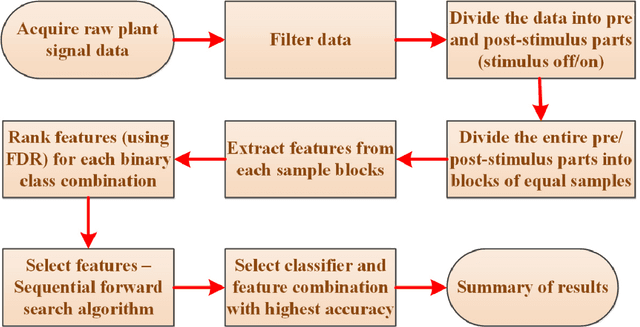
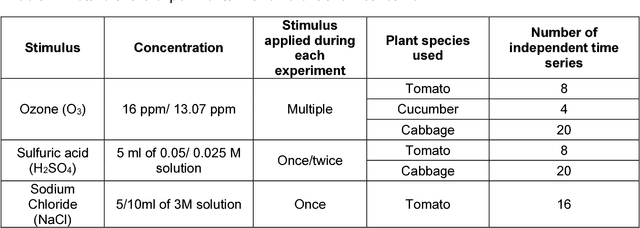
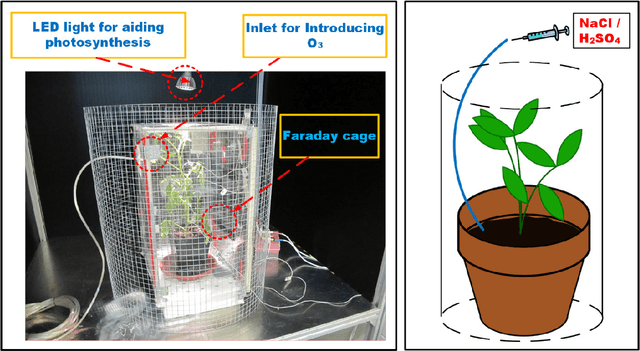

Abstract:Plants monitor their surrounding environment and control their physiological functions by producing an electrical response. We recorded electrical signals from different plants by exposing them to Sodium Chloride (NaCl), Ozone (O3) and Sulfuric Acid (H2SO4) under laboratory conditions. After applying pre-processing techniques such as filtering and drift removal, we extracted few statistical features from the acquired plant electrical signals. Using these features, combined with different classification algorithms, we used a decision tree based multi-class classification strategy to identify the three different external chemical stimuli. We here present our exploration to obtain the optimum set of ranked feature and classifier combination that can separate a particular chemical stimulus from the incoming stream of plant electrical signals. The paper also reports an exhaustive comparison of similar feature based classification using the filtered and the raw plant signals, containing the high frequency stochastic part and also the low frequency trends present in it, as two different cases for feature extraction. The work, presented in this paper opens up new possibilities for using plant electrical signals to monitor and detect other environmental stimuli apart from NaCl, O3 and H2SO4 in future.
Exploring Strategies for Classification of External Stimuli Using Statistical Features of the Plant Electrical Response
Nov 29, 2016
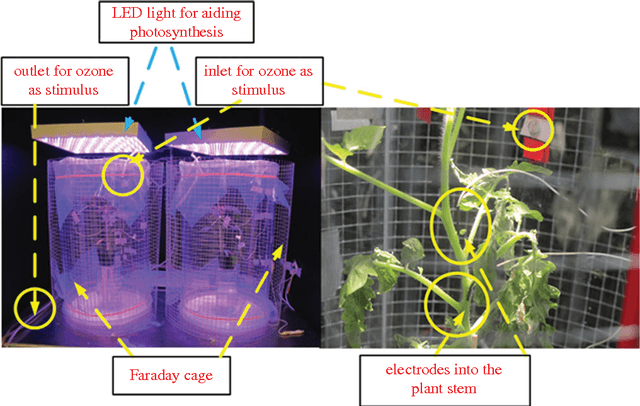
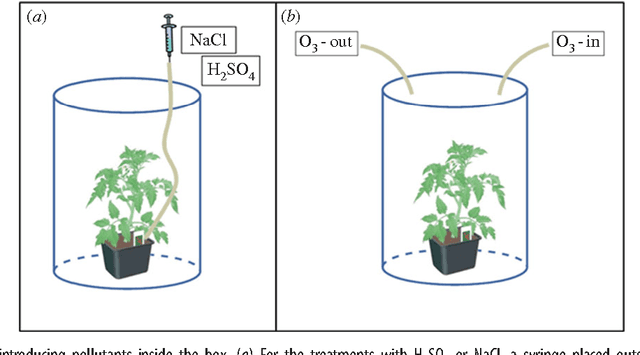
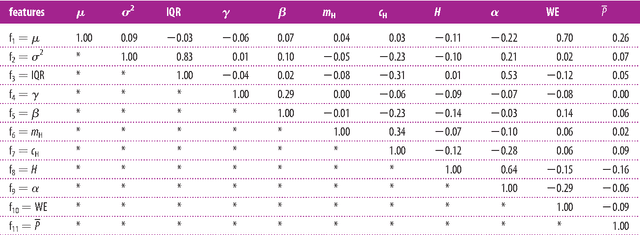
Abstract:Plants sense their environment by producing electrical signals which in essence represent changes in underlying physiological processes. These electrical signals, when monitored, show both stochastic and deterministic dynamics. In this paper, we compute 11 statistical features from the raw non-stationary plant electrical signal time series to classify the stimulus applied (causing the electrical signal). By using different discriminant analysis based classification techniques, we successfully establish that there is enough information in the raw electrical signal to classify the stimuli. In the process, we also propose two standard features which consistently give good classification results for three types of stimuli - Sodium Chloride (NaCl), Sulphuric Acid (H2SO4) and Ozone (O3). This may facilitate reduction in the complexity involved in computing all the features for online classification of similar external stimuli in future.
* 22 pages, 7 figures, 9 tables
On the Existence of Synchrostates in Multichannel EEG Signals during Face-perception Tasks
Nov 29, 2016



Abstract:Phase synchronisation in multichannel EEG is known as the manifestation of functional brain connectivity. Traditional phase synchronisation studies are mostly based on time average synchrony measures hence do not preserve the temporal evolution of the phase difference. Here we propose a new method to show the existence of a small set of unique phase synchronised patterns or "states" in multi-channel EEG recordings, each "state" being stable of the order of ms, from typical and pathological subjects during face perception tasks. The proposed methodology bridges the concepts of EEG microstates and phase synchronisation in time and frequency domain respectively. The analysis is reported for four groups of children including typical, Autism Spectrum Disorder (ASD), low and high anxiety subjects - a total of 44 subjects. In all cases, we observe consistent existence of these states - termed as synchrostates - within specific cognition related frequency bands (beta and gamma bands), though the topographies of these synchrostates differ for different subject groups with different pathological conditions. The inter-synchrostate switching follows a well-defined sequence capturing the underlying inter-electrode phase relation dynamics in stimulus- and person-centric manner. Our study is motivated from the well-known EEG microstate exhibiting stable potential maps over the scalp. However, here we report a similar observation of quasi-stable phase synchronised states in multichannel EEG. The existence of the synchrostates coupled with their unique switching sequence characteristics could be considered as a potentially new field over contemporary EEG phase synchronisation studies.
* 30 pages, 22 figures, 2 tables
Fast Approximate Bayesian Computation for Estimating Parameters in Differential Equations
Jul 17, 2015
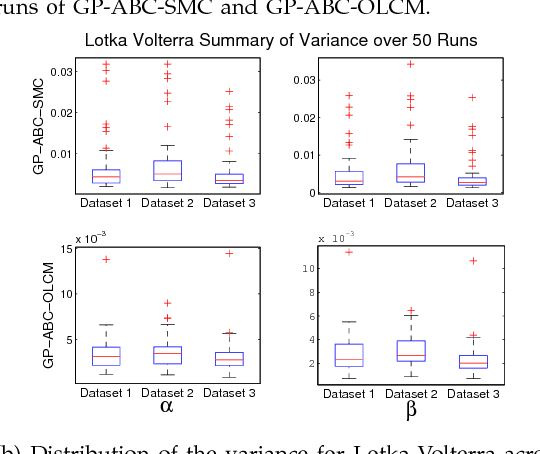

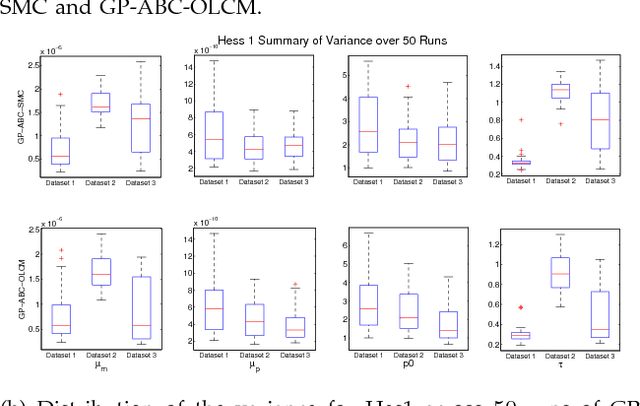
Abstract:Approximate Bayesian computation (ABC) using a sequential Monte Carlo method provides a comprehensive platform for parameter estimation, model selection and sensitivity analysis in differential equations. However, this method, like other Monte Carlo methods, incurs a significant computational cost as it requires explicit numerical integration of differential equations to carry out inference. In this paper we propose a novel method for circumventing the requirement of explicit integration by using derivatives of Gaussian processes to smooth the observations from which parameters are estimated. We evaluate our methods using synthetic data generated from model biological systems described by ordinary and delay differential equations. Upon comparing the performance of our method to existing ABC techniques, we demonstrate that it produces comparably reliable parameter estimates at a significantly reduced execution time.
Prediction of Synchrostate Transitions in EEG Signals Using Markov Chain Models
Oct 20, 2014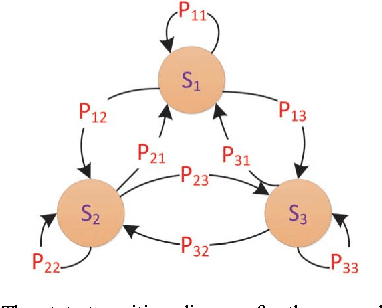
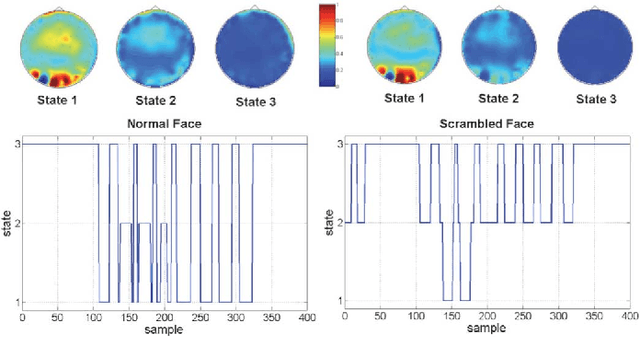
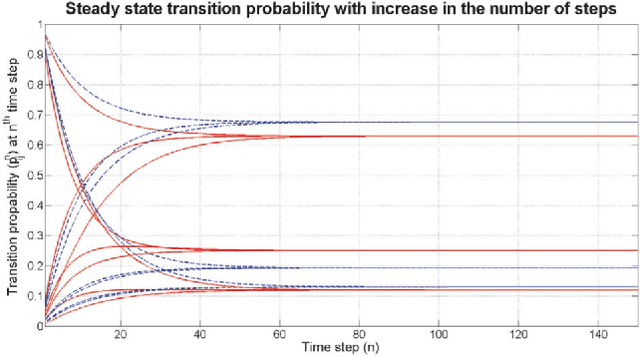
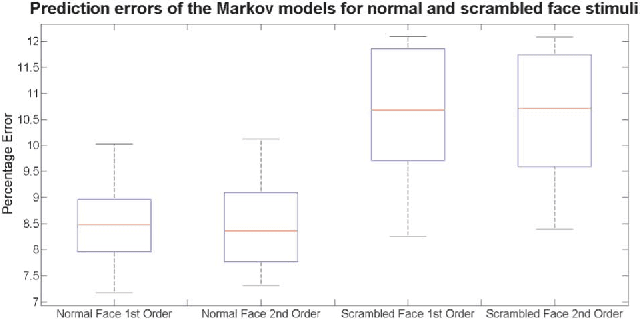
Abstract:This paper proposes a stochastic model using the concept of Markov chains for the inter-state transitions of the millisecond order quasi-stable phase synchronized patterns or synchrostates, found in multi-channel Electroencephalogram (EEG) signals. First and second order transition probability matrices are estimated for Markov chain modelling from 100 trials of 128-channel EEG signals during two different face perception tasks. Prediction accuracies with such finite Markov chain models for synchrostate transition are also compared, under a data-partitioning based cross-validation scheme.
* 5 pages, 5 figures
Classification of Autism Spectrum Disorder Using Supervised Learning of Brain Connectivity Measures Extracted from Synchrostates
Oct 20, 2014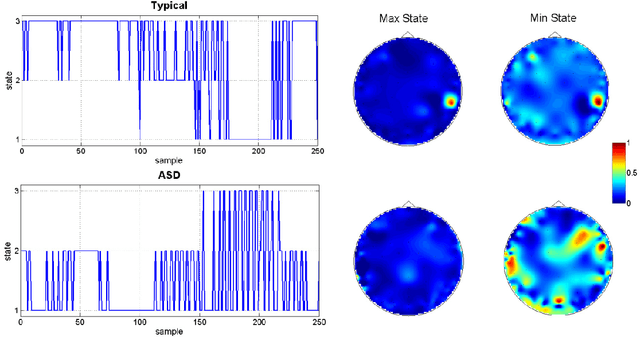
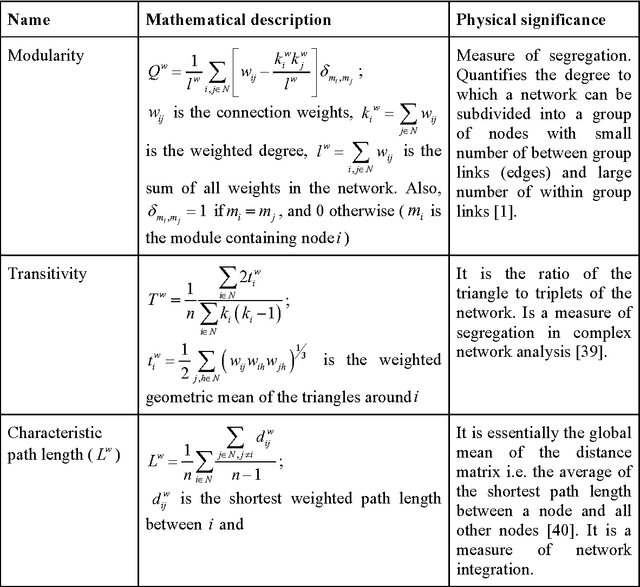

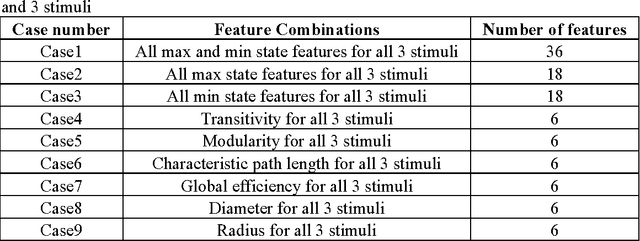
Abstract:Objective. The paper investigates the presence of autism using the functional brain connectivity measures derived from electro-encephalogram (EEG) of children during face perception tasks. Approach. Phase synchronized patterns from 128-channel EEG signals are obtained for typical children and children with autism spectrum disorder (ASD). The phase synchronized states or synchrostates temporally switch amongst themselves as an underlying process for the completion of a particular cognitive task. We used 12 subjects in each group (ASD and typical) for analyzing their EEG while processing fearful, happy and neutral faces. The minimal and maximally occurring synchrostates for each subject are chosen for extraction of brain connectivity features, which are used for classification between these two groups of subjects. Among different supervised learning techniques, we here explored the discriminant analysis and support vector machine both with polynomial kernels for the classification task. Main results. The leave one out cross-validation of the classification algorithm gives 94.7% accuracy as the best performance with corresponding sensitivity and specificity values as 85.7% and 100% respectively. Significance. The proposed method gives high classification accuracies and outperforms other contemporary research results. The effectiveness of the proposed method for classification of autistic and typical children suggests the possibility of using it on a larger population to validate it for clinical practice.
* 27 pages, 17 figures
Artifact reduction in multichannel pervasive EEG using hybrid WPT-ICA and WPT-EMD signal decomposition techniques
Oct 20, 2014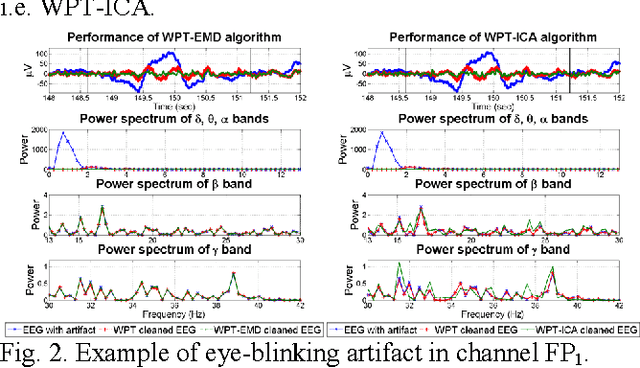
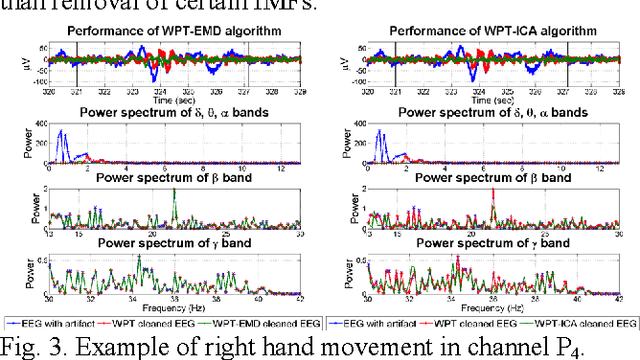
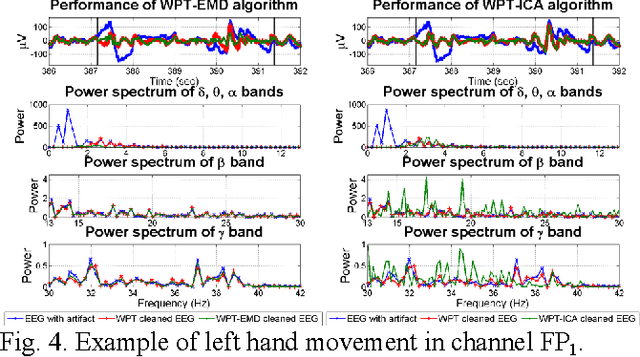
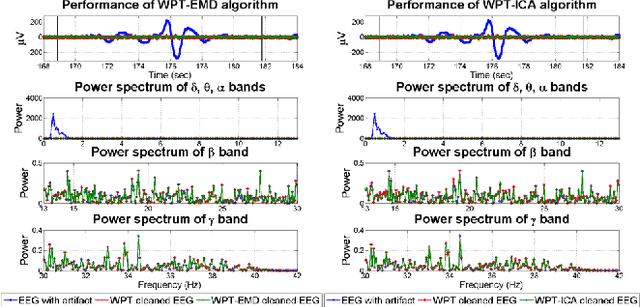
Abstract:In order to reduce the muscle artifacts in multi-channel pervasive Electroencephalogram (EEG) signals, we here propose and compare two hybrid algorithms by combining the concept of wavelet packet transform (WPT), empirical mode decomposition (EMD) and Independent Component Analysis (ICA). The signal cleaning performances of WPT-EMD and WPT-ICA algorithms have been compared using a signal-to-noise ratio (SNR)-like criterion for artifacts. The algorithms have been tested on multiple trials of four different artifact cases viz. eye-blinking and muscle artifacts including left and right hand movement and head-shaking.
* 5 pages, 6 figures
 Add to Chrome
Add to Chrome Add to Firefox
Add to Firefox Add to Edge
Add to Edge